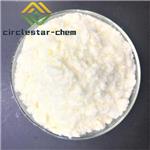Description
1,5,7-Triazabicyclo[4.4.0]dec-5-ene (TBD) is a bicyclic guanidine that has found extensive application in organic chemistry, notably as a powerful catalyst for polymer synthesis and recycling, CO2 utilization, and carboxylic acid derivative synthesis. Bearing both a nucleophilic nitrogen and an electrophilic N?H group, TBD is a multifunctional reagent. It can serve as an organic superbase, an acyl transfer reagent, and a hydrogen bonding activator. It is an excellent catalyst for Michael and Michael-type reactions. The readily available organocatalyst 1,5,7-triazabicyclo[4.4.0]dec-5-ene (TBD) was used for the rapid synthesis of 3-hydroxyisoindolin-1-ones from 3-alkylidenephthalides[1-2].
Chemical Properties
Light yellow crystalline
Uses
1,5,7-Triazabicyclo[4.4.0]dec-5-ene may be used as organocatalyst for aminolysis of esters. It may be used as catalyst for direct addition of P(O)-H bonds (dialkyl phosphites and diphenyl phosphonite) across various activated alkenes. Polymer supported 1,5,7-triazabicyclo[4.4.0]dec-5-ene (PTBD) was used as a base and a reagent scavenger for the synthesis of aryl ethers from phenols and alkyl or aryl halides.
Definition
ChEBI: 3,4,6,7,8,9-hexahydro-2H-pyrimido[1,2-a]pyrimidine is a member of pyrimidines.
General Description
1,5,7-Triazabicyclo[4.4.0]dec-5-ene, a bicyclic guanidine base, has been found to be an excellent catalyst for Michael and Michael-type reactions. It forms 1:1 complex with lasalocid acid and crystal structure of the complex has been studied by X-ray diffraction, FT-IR spectroscopy and
1H NMR.
Reactivity Profile
1,5,7-Triazabicyclo[4.4.0]dec-5-ene (TBD) is a strong bicyclic guanidine base with a pKa = 24.97. It has been shown to promote various reactions, including the Horner–Wadsworth–Emmons reactions, nitroaldol (Henry) reaction, secondary amine alkylation, carboxylation of propylene glycol with CO2, Michael reactions, synthesis of symmetrically N, N′-substituted ureas, 5- and 6-enolexo aldolisation of acyclic ketoaldehydes, intramolecular aldolization of acyclic ketoaldehydes etc. In these reactions, TBD shows good activity and selectivity[3].
reaction suitability
reaction type: solution phase peptide synthesis
reactivity: proton reactive
Purification Methods
1,5,7-Triazabicyclo[4.4.0]dec-5-ene crystallises from Et2O but readily forms white crystals of the carbonate. It is a strong base (see pK, i.e. about 100 times more basic than tetramethylguanidine). The picrate has m 220.5-222o (from EtOH). It forms the 5-nitro derivative m 14.5-160o that gives a 5-nitro nitrate salt m 100-101o (from EtOH/Et2O) and a 5-nitro picrate m 144-145o (from H2O) [McKay & Kreling Can J Chem 35 1438 1957, Schwesinger Chimia 39 369 1985, Hilpert et al. J Chem Soc, Chem Commun 1401 1983, Kamfen & Eschenmoser Helv Chim Acta 72 185 1989]. [Beilstein 26 III/IV 60.]
References
[1] Chunling Blue Lan, Prof. Karine Auclair. “1,5,7-Triazabicyclo[4.4.0]dec-5-ene (TBD): An Organocatalyst for Rapid Access to 3-Hydroxyisoindolin-1-ones.” European Journal of Organic Chemistry 27 12 (2024).
[2] Weiping Ye. “1,5,7-Triazabicyclo[4.4.0]dec-5-ene (TBD) catalyzed Michael reactions.” Tetrahedron Letters 46 40 (2005): Pages 6875-6878.
[3] Iuliana Cota . “1,5,7-Triazabicyclo[4.4.0]dec-5-ene (TBD) an efficient homogeneous catalyst for aldol condensation reactions. Study of the catalyst recovery and reusability using CO2.” Tetrahedron Letters 52 3 (2011): Pages 385-387.
![1,5,7-Triazabicyclo[4.4.0]dec-5-ene Structure](https://www.chemicalbook.com/CAS/GIF/5807-14-7.gif)



